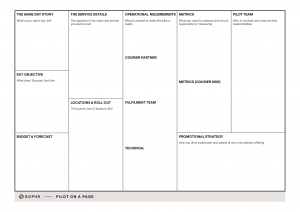Same-day delivery is a simple concept that’s difficult to get right in practice. Getting it right requires a well-planned pilot programme; with a clearly defined objective, and all the important operational dependencies considered… and that’s just for starters.
From working on pilots of all shapes and sizes, we’ve learnt that a great pilot is not just an operational framework, it’s actually an iterative process requiring c-level attention to fine-tune both internal processes and external marketing efforts over the first 3 months.
To help incorporate this kind of thinking into your next pilot, we’ve pulled together 9 different requirements and ‘how to’ explainer notes below. And, we’ve created a one-page planning template, that you can download if you want to cut to the chase.

Here’s what you’ll need to consider:
1. THE SAME DAY STORY
What’s your ‘sell’?
Are you solving a customer problem, making better use of your store network, or launching a sector-first offering?
2. KEY OBJECTIVE
What does ‘success’ look like?
Identify the key objective from the outset so you can measure against it.
3. BUDGET & FORECAST
Have a level of investment in mind, then work through the pilot plan with your delivery partner to stress test and get a better sense of ROI.
4. THE SERVICE DETAILS
The specifics of the same day service you want to test.
Be clear on the details incl. cost to the customer (will you subsidise or add a margin?) store range, delivery speed, time slots offered, vehicles required, order / in-store workflow etc.
5. LOCATIONS & ROLL OUT
The journey from 2 stores to 200.
Consider what you need to test and learn to get there. Set an aggressive but realistic timeline. Don’t oversell in one region that will be impossible to deliver in another, and do try and be consistent in the nationwide offering.
6. OPERATIONAL REQUIREMENTS
What is needed to make this pilot a reality?
COURIER PARTNER
– Coverage locations
– Coverage by vehicle types
– SLA of 90%+
– Customer service provision
– Profitability projections (what scale do they need to make the service sustainable)
FULFILMENT TEAM
What processes/people need to be put in place to ensure deliveries are ready to be collected.
TECHNICAL
Service interface, inventory management & customer service setup are key. But technical implementation can be a real holdup, so think how ‘manual’ you can make the initial set up (e.g. teams booking deliveries manually with CSVs rather than full API integration).
7. METRICS
Include phase 1 targets where possible, and agree on who is responsible for getting those numbers. Examples include;
– On-time deliveries
– Delivery duration
– Average delivery distances
– Cost per delivery
– Customer service requests
– Customer satisfaction
METRICS (COURIER SIDE)
Examples include;
– Acceptance times
– Pick up times (from acceptance to pick up)
– Delivery success
– Courier ratings
– Courier satisfaction
8. PILOT TEAM
Who is involved and what are their responsibilities?
Compile a cross-functional same day pilot team with defined roles and responsibilities.
Every pilot needs exec-level buy-in to make it work. And we’re not just talking sign-off, but a member of the C-suite who is bought in and will help make things happen.
Consider additional ‘recruits’ from…
– Logistics and Supply
– Ecommerce team
– Store management team
– Marketing and PR
– Tech/Dev team
– Both sides
9. PROMOTIONAL STRATEGY
How you drive awareness and uptake of your new delivery offering?
Driving awareness and demand for the new service is key. Trial a series of different tactics and localised channels to understand what works (and when) and then repeat as you expand. Free / price promo on delivery, SMS, onsite, in-store, direct mail, social media, radio, local press can all play a role.
If you need any help or have any questions about running a pilot, get in touch with us (sales@gophr.com) and we’ll be happy to chat.


